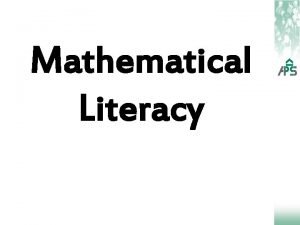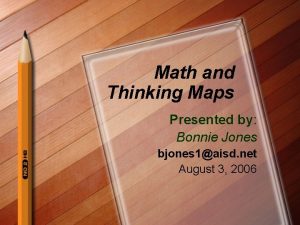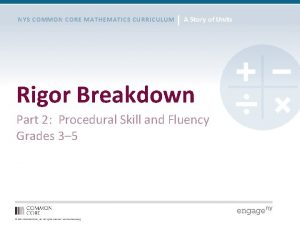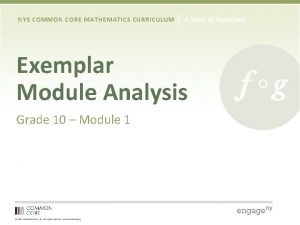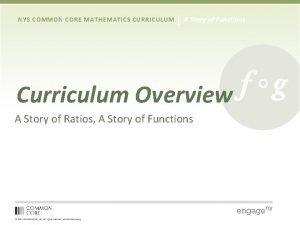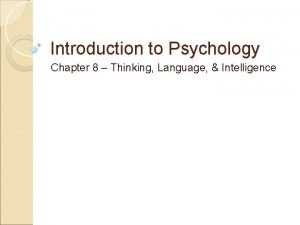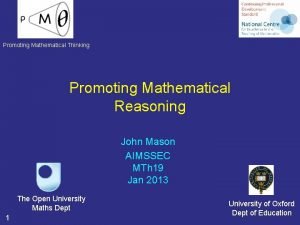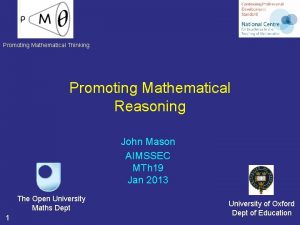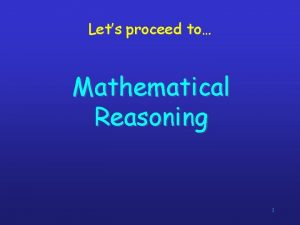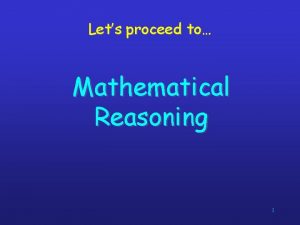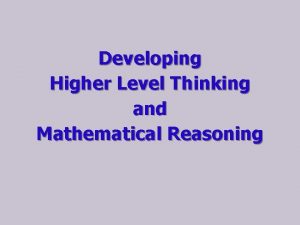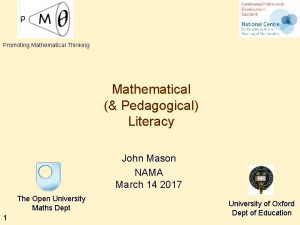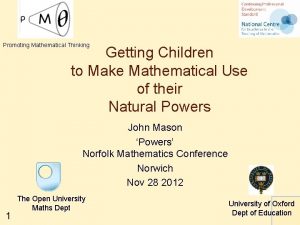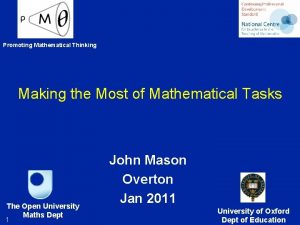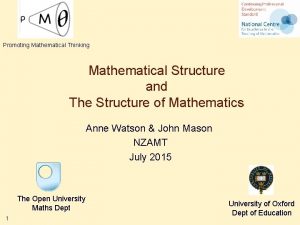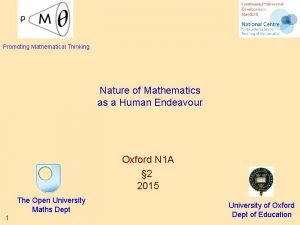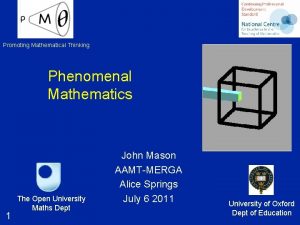Promoting Mathematical Thinking Reasoning in the Mathematics Curriculum
















- Slides: 16

Promoting Mathematical Thinking Reasoning in the Mathematics Curriculum Anne Watson & John Mason Prince’s Trust Maths CPD London Mar 2 Manchester Mar 9 2013 The Open University 1 Maths Dept University of Oxford Dept of Education

Conjectures v v v 2 Everything said here today is a conjecture … to be tested in your experience The best way to sensitise yourself to learners … … is to experience parallel phenomena yourself So, what you get from this session is what you notice happening inside you!

Differing Sums of Products v Write down four numbers in a 2 by 2 grid v Add together the products along the rows 28 + 15 = 43 v Add together the products down the columns 20 + 21 = 41 v Calculate the difference 43 – 41 = 2 v v 3 That is the ‘doing’ What is an ‘undoing’? Now choose positive numbers so that the difference is 11 4 7 5 3

Differing Sums & Products v Tracking Arithmetic 4 x 7 + 5 x 3 4 7 5 3 4 x 5 + 7 x 3 4 x(7– 5) + (5– 7)x 3 = (4 -3)x (7– 5) 4 v So in how many essentially different ways can 11 be the difference? v So in how many essentially different ways can n be the difference?

Think Of A Number (Th. OANs) v v v v v 5 Think of a number Add 2 Multiply by 3 Subtract 4 Multiply by 2 Add 2 Divide by 6 Subtract the number you first thought of Your answer is 1 7 7 +2 3 x 7 + 6 3 x 7 + 2 6 x 7 + 4 6 x 7+ 6 7+1 1

Equilateral Construction v v 6 AC is twice AB M is the mid-point of CD AB is perpendicular to AC, as is DC How long should CD be so that BMC is equilateral?

Mathematical Thinking v v 7 How describe the mathemtical thinking you have done so far today? How could you incorporate that into students’ learning?

Possibilities for Action v v v 8 Trying small things and making small progress; telling colleagues Pedagogic strategies used today Provoking mathematical thinks as happened today Question & Prompts for mathematcal Thinking (ATM) Group work and Individual work

Reflection v v v KNOW & WANT Specialisng & Generalising Identifying variables; focus on relationships STUCK? Try another route Parking “what you can do” Doing & Reflecting on Doing – Make up own – Cf with neighbour – Explain; Narrate v v 9 Recognising familiar structures Searching past experience Imagining & Expressing Generating space of possibilities v v v How Do You Know? Choosing egs to get variety (for comparisons, for same & different) Visual perception –> conjectures; reasoning to achieve certainty Dynamic images to indicate relationships; scope of generality “it” –> what is ‘it’? Cognitive conflict & surprise – Something to discuss v Impossible tasks (How do you know)

Proof by Sorting & Ordering 10

Graphical Reasoning Say What You See v Lines are y = 3 x - 1 3 y = -x + 7 y = 3 x + 9 3 y = -x+ 17 11

Compound % v v At a discount store, I can get a discount of 30% Should I prefer to calculate the VAT of 20% before or after calculating the discount? What would Customs and Revenue prefer? Simpler Question: – If VAT is 20% and there is a local tax of 10%, what is the overall tax? – To whom does it matter in which order they are calculated? 12

Money Changing v v 13 People who convert currencies offer a ‘buy’ rate and a ‘sell’ rate, and sometimes charge a commission in addition! Suppose they take p% from every transaction, and that they sell $s for 1£ but buy back at the rate of £b for $1. How can you calculate the profit that make on each transaction?

Reflection v v v v Surprise Variation How do you know? Sorting & ordering Tracking arithmetic Multiple representation Attention, Action & Awareness – Teacher’s – Students’ 14

Tasks v v 15 Tasks promote Activity; Activity involves Actions; Actions generate Experience; – but one thing we don’t learn from experience is that we don’t often learn from experience alone It is not the task that is rich … – but whether it is used richly

Follow Up v v v v 16 j. h. mason @ open. ac. uk mcs. open. ac. uk/jhm 3 Presentations Questions & Prompts (ATM) Key ideas in Mathematics (OUP) Learning & Doing Mathematics (Tarquin) Thinking Mathematically (Pearson) Developing Thinking in Algebra
 Promoting alternative thinking strategies
Promoting alternative thinking strategies What is mathematical economics
What is mathematical economics Mathematical literacy pictures
Mathematical literacy pictures Nductive reasoning
Nductive reasoning Deductive vs inductive geometry
Deductive vs inductive geometry What is inductive reasoning
What is inductive reasoning Inductive reasoning patterns
Inductive reasoning patterns Inductive vs deductive reasoning
Inductive vs deductive reasoning Inductive approach
Inductive approach Deductive vs inductive
Deductive vs inductive Using mathematics and computational thinking
Using mathematics and computational thinking Thinking maps mathematics
Thinking maps mathematics Nys common core mathematics curriculum
Nys common core mathematics curriculum Nys common core math
Nys common core math Whats common
Whats common Thinking, language, memory, and reasoning are all part of
Thinking, language, memory, and reasoning are all part of Perbedaan critical thinking dan creative thinking
Perbedaan critical thinking dan creative thinking


